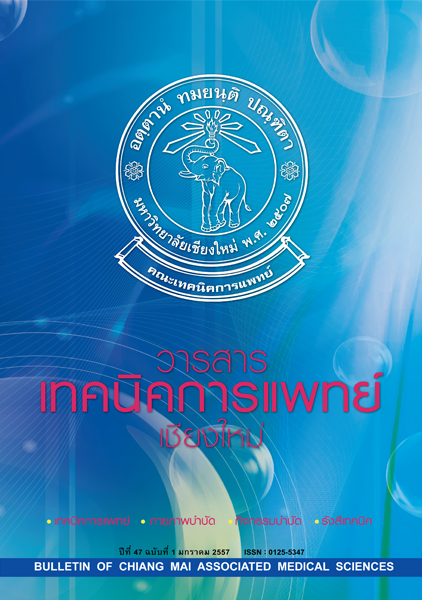A comparison of curve-fitting models for MRI T2* measurements of a gel-phantom at different levels of signal to noise ratio
Main Article Content
Abstract
Introduction: T2* measurement using magnetic resonance imaging (MRI) becomes a standard method for evaluation of iron deposit in organs. Therefore, accuracy of the measurement is important. Factors affected to the accuracy of T2* values are signal-to-noise ratio (SNR) and curve-fitting models.
Objectives of the study: We proposed a phantom study to compare the accuracy and reproducibility of the T2* when curve-fitting models, different iron concentrations, and levels SNR were changed.
Materials and methods: A gel phantom was built with 8 different Fe3+ concentrations. Axial view phantom images were acquired using a 1.5-T Achieva, Philips MRI scanner along with a head coil. Setting parameters were: acquisition matrix 184x183, reconstruction matrix 512 x 512, field-of-view 275 mm, and slice thickness 1.5 mm. The gradient multi-echo pulse sequence was applied with 32 echo times (TEs) 4.48 ms to 81.98 ms, inter-echo time 2.5 ms, TR 800 ms, and flip angle 18 degrees. All data were acquired with 5 different numbers of signal averages (NSAs) to generate 5 levels of SNRs. Total scan time at NSA1=2.29 s. Data of Fe3+ concentrations at all levels of SNRs were fitted with five curve-fitting models. The accuracy of T2*s in each fitting model was evaluated by Pearson’s correlation (r) between reference T2*s and the T2*s obtained from the 5 fitting models at all levels of SNRs. The linear regression between the R2*s (1/T2*), and Fe3+ concentrations were also analyzed, and were compared between that of the reference to those of the 5 fitting models at all levels of SNRs. All analysis was performed on a PC using MATLAB version 7.2.0.232 (Mathworks, Natick, MA, USA), MS Excel, and GraphPad Prism4.
Results: Results showed that at the range of T2* 3.13-44.04 ms, the baseline subtraction and offset models tend to offer high accuracy of T2*s and robust to the changes of SNR (r >0.9960 at all levels of SNRs). Simple mono-exponential model demonstrates no correlation at low SNR (r = -0.2869, and 0.1835). The accuracy of T2*s obtained from truncation models is proportional to the levels of SNRs (0.7113<r<0.9993). The bi-exponential model provides reasonable accurate T2* (r>0.9600) but it is not proportional to the levels of SNR.
Conclusions: Results implied that baseline-subtraction and offset models provide the most accurate and robust T2*, simple mono-exponential and Truncation models may present less reliable T2* at low SNR image data, and the bi-exponential model offers reliable T2* but the values are sensitive to the changes of SNRs.
Bull Chiang Mai Assoc Med Sci 2014; 47(1): 10-17
Article Details
Personal views expressed by the contributors in their articles are not necessarily those of the Journal of Associated Medical Sciences, Faculty of Associated Medical Sciences, Chiang Mai University.


